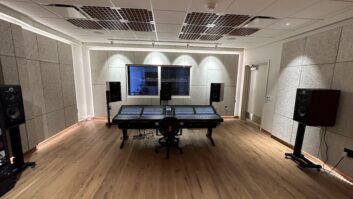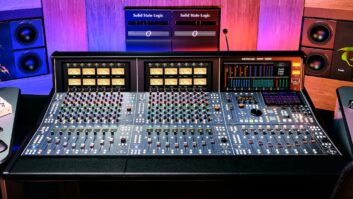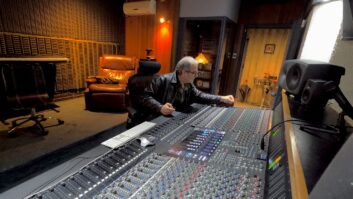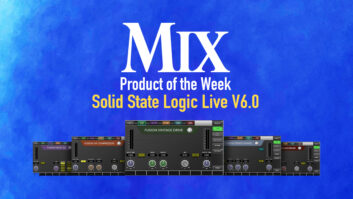Ardent Studios has completely remodeled the control room of Studio C and installed a Duality console from Solid State Logic. Pictured in the room are (l-r): chief technical engineer Chris Jackson, founder John Fry
and studio manager/Big Star drummer Jody Stephens.With the heyday of the record industry and bigbudget album projects now apparently little more than a distant memory, recording studio owners have had to adapt their business models to align with a new reality. The ongoing recession has had an impact, of course, and there are certain other pressures in play, yet work is still there to be done, and for some that has presented a variety of opportunities.

If there is one overarching trend in the record-making business—and it’s one that has been ongoing for some time—it is that the major record labels are less and less involved with projects financially. “A lot of our business is the artist booking the studio directly, their management company paying for it, and then licensing it to the labels,” reports Allen Sides, an engineer and producer and the owner of Ocean Way Recording, which maintains a historic recording complex in Hollywood as well as facilities in Sherman Oaks and the Caribbean.
“It used to be that everything we did was a record company P.O.; now a lot more is artist-direct. That’s been a change in the last couple of years,” says Sides.
John Fry, founder of Ardent Studios in Memphis, and also an engineer, producer and record label owner, agrees: “Like most people, we see a lot more of our work coming from nontraditional sources, a lot less of it coming from the large record companies and a lot more coming from independent labels and artists and various self-financed projects.”
Ardent and Ocean Way are institutions, facilities with long histories of legendary record projects that have weathered the ups and downs of the economy and the music business over the decades. At the other end of the scale, the new reality of independently financed projects has also inspired start-ups studios, including Virtue and Vice, in the Greenpoint neighborhood of Brooklyn.
Anthony Gallo, who was formerly the chief engineer at Cutting Room Studios in Manhattan, opened Virtue and Vice recently after seeing major recording sessions in the classic sense largely fade away. Instead, the new way of making records typically involves a group of people—once the drums are recorded—getting creative in the control room.
Virtue and Vice, an 800-square-foot commercial loft space, comprises a single control/live room plus a booth for vocal and instrument overdubs. “What I’ve done with this place is really create an environment that inspires you to be comfortable and create and do the work that is 90 percent of a record, which is everything past the drums,” Gallo explains. “You just use somebody else’s place to do the drums.”
Gallo seems happy to see the back of the record labels. “This label, we’ll call them X, owed me $300; it took them 14 months to get it to me! So the label work, financially, doesn’t interest me too much. But we all want to work with bigger bands—and you still get a lot of great projects with independent people.”
A major attraction of facilities such as Ardent and Ocean Way is the great environments and classic equipment, of course. Inexpensive digital gear may have facilitated home studios, but, notes Sides, “Most everybody that I know prefers mixing on analog consoles. Even if they’re at home they’re summing it out in groups and bringing in back in. It’s such a tremendous difference in sonic quality that it’s becoming the way to do it, and various manufacturers are making boxes specifically for that purpose.”
Ardent, a three-room complex that has long favored analog Neve and SSL consoles, recently swapped out a vintage Neve V in Studio C for a new SSL Duality. “[That] is going to save us a lot of maintenance headaches and certainly speed up our workflow considerably in that room, and our efficiency,” says Fry. “You just have to adapt to changing conditions and try to provide people with what they want, and what a lot of these clients want is efficiency. They want to get good value for money and a lot done expeditiously.”
Equipment upgrades have been kept to a minimum, he adds. “Generally speaking, we’ve been pretty conservative because of the economic conditions both within the recorded music industry and the country.”
Those vintage analog consoles and outboard gear are a major selling point for Ardent’s rooms. “We have a lot of people who want to use those devices for parts of their projects or, in some cases, the entirety. It’s amazing how a lot of young people are gravitating back toward making use of that technology and want to use things like real analog tape for some part of their project. Maybe it’s just the initiation and not the entire project. Many of them prefer to use the real analog outboard equipment as opposed to a plug-in that attempts to imitate it,” Fry observes.
At the other end of the scale, Gallo has outfitted his room with a minimal complement of high-quality gear. “I don’t want to sound like I know everything, but I realized that there are a couple of things you can get away with, and get away with not buying, and not building,” he elaborates.
Technology can be a double-edged sword, he believes: “There are so many times where you’re skipping over stuff and the reality is that with technology comes great opportunities to have advances but sometimes it’s a bad thing. For a lot of people, they think of it as opportunities to skip stuff rather than make life just a little bit easier.”
With the current state of the record industry, music making will only ever be a hobby for some artists. “Delusions of grandeur can be kept at the door,” says Gallo. “I don’t like to tell people that, but that’s the reality.”
Artists might aspire to recording at a traditional commercial facility, Gallo continues, but the rates are too high for many, a situation that led to his decision to establish Virtue and Vice. “As much as I loved being at the Cutting Room, my clients couldn’t afford it. And I found myself making more money mixing out of my bedroom with my HD rig than I would there [at the Cutting Room].”
Gallo was smart about the money that he put into his new room. “I realized I needed to get the best of a couple of things and spend it elsewhere, so I’ve paid for all my stuff,” he points out. “Some of us are not working 20 days [per month] to break even.”
A lower initial outlay meant less risk, but Gallo had little reason to worry, as it turns out. “I don’t know if it’s because I’ve finally hit my stride after eight years of doing this, not really making any enemies and becoming friends with my clients, but it’s worked out really well. I know a whole bunch of other guys in the neighborhood are doing well, too.”
Ocean Way’s clients are typically A-list artists, but while the labels may have taken a back seat there has been no decrease in work, thanks to a robust concert tour market. “I would say artists are even more concerned to some degree about putting out albums, because they have to support the tours,” notes Sides.
Just because current audio technology enables home studios to be built it doesn’t necessarily follow that the results will match the quality of a commercial recording studio, and that’s created another opportunity for Sides. “Two major record companies have come to me; they’re concerned with getting a little higher quality music from some of the newer artists,” he reports. “Some of the stuff is so poorly recorded and poorly done that they’d like to add a little bit of production value, so it’s a little bit slicker, and bring the overall quality up, without spending a ton of money.”
Sides has also been able to step into projects that include a home studio component early enough to ensure that the audio quality doesn’t suffer. “At any given time we’ll have a number of our clients who will set up at their house. I’ll come in and help set up the sound of the room so we can record guitars and vocals with good mic pres and good EQs. They don’t need a console, but they do need things recorded well.”
Ardent has built such a reputation over its 45 years in operation that recording artists now come from far and wide, according to Fry. “We have people from around the country and a good many international clients. We’ve done several projects for folks from Holland lately, and we have some fairly regular clients from Japan and Australia.”
Not that Ardent is necessarily recession-proof, but the poor state of the U.S. economy has certainly worked in Fry’s favor of late: “Particularly since the U.S. dollar has tended to be rather weak against foreign currencies, it’s been a little easier for some of these international people to record in the United States.”







